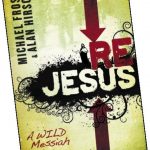Frost, Michael and Hirsch, Alan. ReJesus: A Wild Messiah for a Missional Church. Hendrickson Publishers, 2009. 9781598562286.
Meet the Authors
Michael Frost and Alan Hirsch have collaborated on numerous projects and are leading voices in the missional church movement. Together, they have co-authored two books: The Shaping of Things to Come: Innovation and Mission for the 21st Century Church and ReJesus: AWild Messiah for a Missional Church.
 Michael Frost (pictured at left) is the Vice Principal (responsible for
Michael Frost (pictured at left) is the Vice Principal (responsible for faculty development) and the Director of the Tinsley Institute at Morling College in Macquarie Park, New South Wales, Australia. In 2002, he planted the missional community Small Boat, Big Sea. Frost has written or co-written eight books.
faculty development) and the Director of the Tinsley Institute at Morling College in Macquarie Park, New South Wales, Australia. In 2002, he planted the missional community Small Boat, Big Sea. Frost has written or co-written eight books.
Alan Hirsch (pictured at right) is the founding Director of Forge Mission Training Network and the co-founder of Shapevine. He is an adjunct professor at Fuller Seminary. Hirsch has written or co-written five books. For more information, visit his Forgotten Ways website.
Book Basics
 ReJesus is intended as a call to Re-Jesus the church by placing Jesus back at the center. The authors claim the book intends to move toward an “absolute recovery of the centrality of the person of Jesus in defining who we are as well as what we do” (p.8) and call upon their readers to “recalibrate the church around the person of Jesus rather than around marketing ploys developed for a shallow consumeristic age” (p.189).
ReJesus is intended as a call to Re-Jesus the church by placing Jesus back at the center. The authors claim the book intends to move toward an “absolute recovery of the centrality of the person of Jesus in defining who we are as well as what we do” (p.8) and call upon their readers to “recalibrate the church around the person of Jesus rather than around marketing ploys developed for a shallow consumeristic age” (p.189).
The authors assert the formula that Christology determines missiology which in turn determines ecclesiology, yet the discerning reader is left wanting more in each of the three categories – especially Christology. The authors do better at challenging and even deconstructing traditional views of Jesus (i.e. through art) than of reconstructing Jesus as the so-called Wild Messiah. Perhaps with a more thorough consideration of Christology via the lens of the Wild Messiah, the arguments for missiology (the strength of these missiologists) and beyond to ecclesiology would be better received and have more practical application for individual believers and congregations.
So What?
The problem identified by Frost and Hirsch is an obvious one: many congregations have placed something other than Jesus at the center of congregational life and mission. In a given local context and with appropriate recognition of postmodern influences, how does your church keep Jesus at the center of congregational life and mission?
To rethink Jesus from a biblical perspective, consider my recent series Who is Jesus?